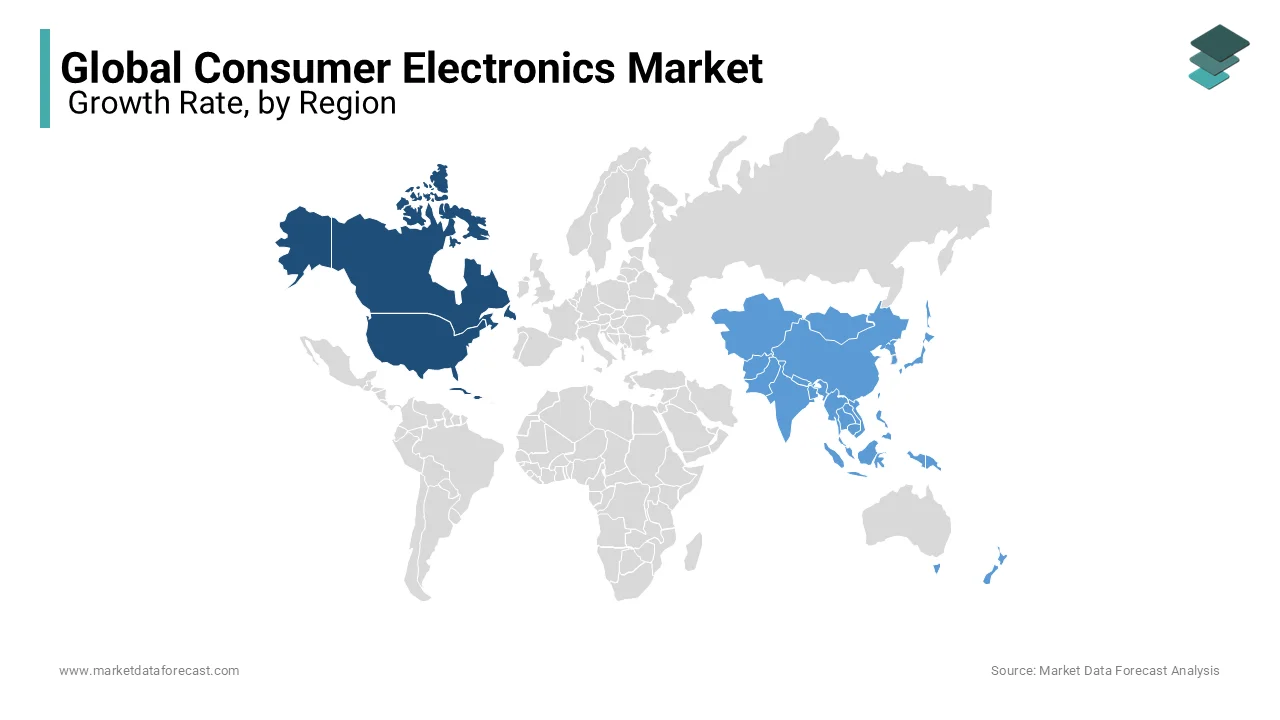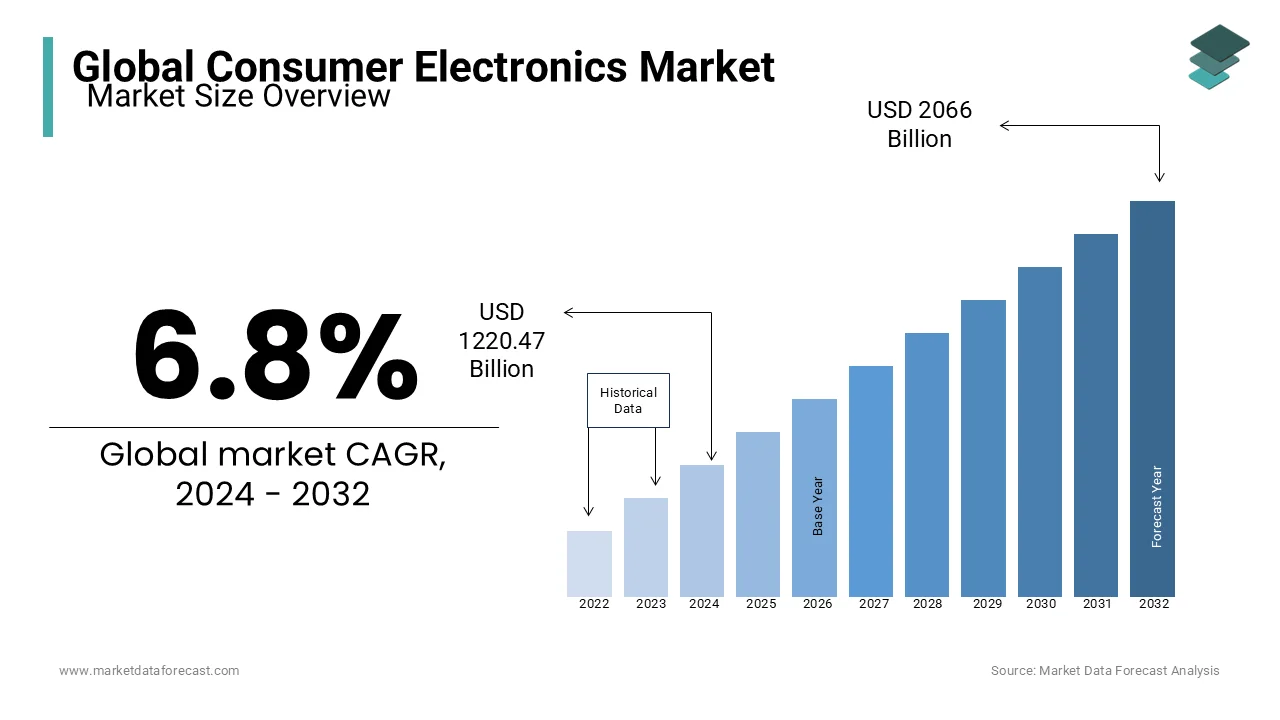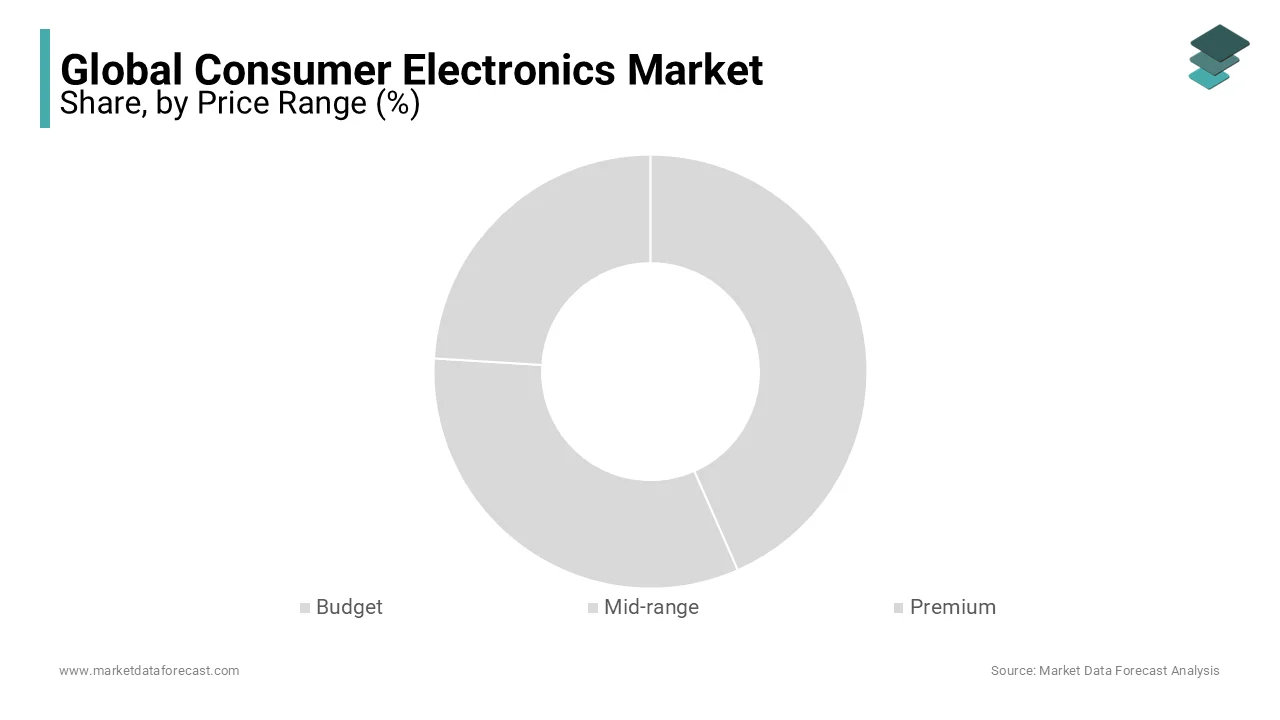Global Consumer Electronics Market Size, Share, Trends, & Growth Forecast Report - Segmented By Product (Smartphones, Tablets, Laptops, Desktop Computers, TVs, Home Appliances, Cameras, Gaming Consoles, Wearables and Accessories), Distribution Channel (Retail Stores, E-Commerce Platforms and Direct-To-Consumer Channels), Price Range (Budget, Mid-Range and Premium) and Region (North America, Europe, APAC, Latin America, Middle East and Africa) – Industry Analysis From 2024 to 2032.
Global Consumer Electronics Market Size (2024 to 2032)
The Global Consumer Electronics Market was worth US$ 1142.76 billion in 2023 and is anticipated to reach a valuation of US$ 2066 billion by 2032 from US$ 1220.47 billion in 2024. It is predicted to register a CAGR of 6.8% during the forecast period 2024-2032.
MARKET DRIVERS
The rising demand for smart gadgets is one of the consumer electronics market's main growth prospects.
The market for wearables, linked gadgets, and smart homes is anticipated to expand as more people use these items. Manufacturers now have an excellent opportunity to innovate and create new items that fit invisibly with consumers' homes and lifestyles. Consumers can gain greater convenience, effectiveness, and security from smart gadgets, among other advantages. For instance, homeowners can manage their houses while away using a smartphone app to remotely control smart home appliances like smart thermostats, lighting, and security systems. In addition, on wearable devices like smartwatches and fitness trackers, customers can choose from various health and fitness-related functions, including heart rate monitoring, activity tracking, and sleep tracking. Manufacturers who innovate and create new smart products that satisfy consumer tastes and needs can become market leaders. Additionally, as the market for smart devices expands, manufacturers can collaborate with businesses in related fields like home security, healthcare, and automotive to diversify their product portfolios and attract new clients.
Technical improvements primarily drive the consumer electronics market. Manufacturers can produce more innovative and inventive electronic products with improved features and capabilities as technology progresses. Consumers are constantly looking for new and enhanced electronic gadgets that can facilitate their daily lives, whether for convenience, entertainment, or communication. Wearables, smart home gadgets, and virtual reality are just a few new and developing categories of electronic products made possible by technological developments. These devices have greatly fueled the expansion of the consumer electronics market. These gadgets provide special capabilities and features not found in conventional electronic devices, such as the capacity to monitor fitness goals, remote-controlled home appliances, and virtual reality worlds. The miniaturization of electrical components has also resulted from technological improvements, making products smaller and more portable. Thus driving demand and growth in the consumer electronics market. Higher disposable incomes might encourage consumers to spend more on upscale goods like high-end smartphones, high-end audio equipment, and cutting-edge gaming systems. To appeal to consumers with higher disposable incomes and spending power, manufacturers may prioritize developing these items, which could result in bigger profit margins and a larger consumer electronics market overall.
MARKET RESTRAINTS
The short product lifecycles of electronic devices are one of the main barriers to the consumer electronics market.
Due to the quick introduction of new and improved electronic gadgets to the market due to technological advancement, previous equipment quickly became obsolete. Because of the short product lifecycle, market companies are pressured to constantly develop and update their products to stay competitive and satisfy shifting consumer needs. However, this might lead to higher R&D expenses and quicker times for product development investments to pay off. Additionally, consumers may experience difficulties due to the short product lifecycle. Consumers might feel pressured to often replace their devices to stay current with technology, which would result in more expenditure on electronic goods. Additionally, as consumers discard older devices in favor of newer ones, the quick obsolescence of older devices can add to the growing issue of electronic waste. Therefore, consumer electronics producers must balance the desire to innovate and update their products with the sustainability of their business practices and the influence on customers and the environment. Therefore, the short product lifecycle is a primary limitation of the consumer electronics market.
REPORT COVERAGE
|
REPORT METRIC |
DETAILS |
|
Market Size Available |
2023 – 2032 |
|
Base Year |
2023 |
|
Forecast Period |
2024 - 2032 |
|
CAGR |
6.8% |
|
Segments Covered |
By Product, By Distribution Channel, By Price Range, By Region |
|
Various Analyses Covered |
Global, Regional, & Country Level Analysis; Segment-Level Analysis, DROC, PESTLE Analysis, Porter’s Five Forces Analysis, Competitive Landscape, Analyst Overview of Investment Opportunities |
|
Regions Covered |
North America, Europe, APAC, Latin America, Middle East & Africa |
|
Market Leaders Profiled |
Apple Inc., Samsung Electronics Co. Ltd., Huawei Technologies Co. Ltd., Xiaomi Corporation, LG Electronics Inc., Sony Corporation, HP Inc., Dell Technologies Inc., Lenovo Group Limited, Panasonic Corporation, Bose Corporation, Canon Inc., Nikon Corporation, GoPro, Inc., Fitbit Inc. |
SEGMENTAL ANALYSIS
Global Consumer Electronics Market Analysis By Product
- Smartphones
- Tablets
- Laptops
- Desktop computers
- TVs
- Home Appliances
- Cameras
- Gaming consoles
- Wearables
- Accessories
The smartphone segment dominated the consumer electronics market based on type in 2022 and the domination is expected to continue throughout the forecast period. Smartphones are essential devices for communication, entertainment, and social media, with capabilities such as high-resolution cameras, sophisticated CPUs, and long battery life. Other significant segments in the consumer electronics market, in addition to smartphones, are laptops, tablets, TVs, and home appliances. Due to the rise of remote work and learning, laptops and tablets have seen increased demand, while TVs and home appliances have experienced increased demand due to the move to home entertainment and home automation. It is vital to remember that a segment's dominance might vary by region and throughout time. Because of lower prices and connectivity limitations, feature phones or basic smartphones may predominate in some emerging nations.
Global Consumer Electronics Market Analysis By Distribution Channel
- Retail stores
- E-commerce platforms
- Direct-to-consumer channels
The e-commerce segment has been the fastest-growing and most dominant globally in the consumer electronics market. E-commerce platforms give consumers the convenience of shopping online from the comfort of their own homes, as well as a diverse selection of products at affordable costs. Online marketplaces like Amazon, Alibaba, and Flipchart have played a vital role in fuelling e-commerce growth in the consumer electronics market. Aside from e-commerce, the consumer electronics market is dominated by retail stores and direct-to-consumer channels. Consumers can see, touch, and test products before purchasing them at retail locations such as Best Buy, MediaMarkt, and Dixons Car Phone. Direct-to-consumer channels, such as Apple's online store, provide consumers with unique access to products and services while also offering a personalized purchasing experience.
Global Consumer Electronics Market Analysis By Price Range
- Budget
- Mid-range
- Premium
The mid-range segment has become the most dominant and is predicted to account for the largest share of the global market during the forecast period. Products in the mid-range class offer a decent blend of features and prices, and they often target the mass-market segment. Other significant divisions in the consumer electronics market, in addition to the mid-range group, include the premium and budget segments. The premium section contains high-end products with premium features, materials, and designs that are typically aimed at the high-end market segment. The budget category covers entry-level products that provide basic functionality at a low cost and often target the low-end market segment.
REGIONAL ANALYSIS
- North America
- Europe
- Asia-Pacific
- Latin America
- Middle East and Africa
North America led the market and is estimated to hold the major share of the global consumer electronics market in the coming years owing to a rising preference for consumer electronics product penetration. These areas are characterized by strong purchasing power, a technologically aware populace, and modern technological infrastructure. The main markets in these regions are the United States and Western Europe, which have a considerable presence of prominent players in the consumer electronics market.

The Asia Pacific region is the largest and fastest-growing consumer electronics market worldwide. A big population, increased disposable income, and a burgeoning middle class are driving the region's growth. China, India, and Japan are the region's largest markets, with a strong presence of key firms and a growing customer base.
KEY MARKET PLAYERS
Apple Inc., Samsung Electronics Co. Ltd., Huawei Technologies Co. Ltd., Xiaomi Corporation, LG Electronics Inc., Sony Corporation, HP Inc., Dell Technologies Inc., Lenovo Group Limited, Panasonic Corporation, Bose Corporation, Canon Inc., Nikon Corporation, GoPro, Inc., Fitbit Inc., and Others.
Frequently Asked Questions
1. What is the Consumer Electronics Market?
The consumer electronics market is the industry involved in designing, manufacturing, marketing, and selling electronic devices and gadgets for personal and household use.
2. What is the market size of the Consumer Electronics Market?
The global consumer electronics market is anticipated to be valued at USD 1142.76 billion in 2023, with an expected growth at a CAGR of 9.04% during the forecast period, reaching USD 2066 billion by 2032.
3. What are the segments covered in the Consumer Electronics Market?
The consumer electronics market segments are product, distribution channel, price range, and region.
Related Reports
Access the study in MULTIPLE FORMATS
Purchase options starting from
$ 2500
Didn’t find what you’re looking for?
TALK TO OUR ANALYST TEAM
Need something within your budget?
NO WORRIES! WE GOT YOU COVERED!
Call us on: +1 888 702 9696 (U.S Toll Free)
Write to us: sales@marketdataforecast.com

